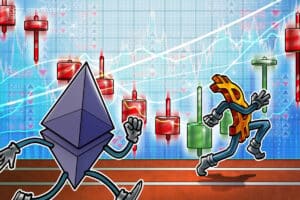How the actor model can enable better blockchain games.

Decentralized applications (DApps), including gaming applications, have received significant attention for their transparency, security, and ownership of user assets. However, delivering high-quality AAA gaming experiences through DApps presents challenges.
Existing 2D game DApps run on blockchain networks using smart contracts for asset management. While they are favored for their simple mechanics and resource efficiency, their limitations become apparent as the complexity of their gameplay increases.
Scalability is a primary obstacle for traditional blockchains such as Ethereum, affecting real-time interactive games due to limitations around transaction execution and latency.
Performance is also an issue. AAA games require a high performance computer and advanced graphics rendering. However, existing DApps struggle to meet these needs, resulting in suboptimal viewing experiences.
Moreover, developing AAA game apps is expensive due to resource-intensive tasks and blockchain implementation fees. Balancing immersive experiences with user-friendly costs complicates the use of traditional DApp frameworks for AAA games.
What is an actor model?
The “actor model” is a communication model that enables parallel computing and asynchronous messaging within the blockchain protocol, allowing developers to build complex DApps with less difficulty.
The actor model is used in the Gear protocol, and development is led by Nikolai Wolff, co-founder of the Gear protocol and Vara, and one of the key developers of Polkadot and the Substrate framework.
In the model there are actors – programs or users that send messages to other programs in the protocol. Each actor has a mailbox and a private state, it cannot be changed directly by another actor, instead they can change states only by receiving a message from another actor.
Messages between actors are taken from the mailboxes and processed in a cycle. After the actor receives and processes the message, it can send the message to another actor, create an actor, or change its state.
How is this useful for DApp development?
Asynchronous message handling on blockchain programming provides several important advantages that contribute to the overall efficiency, scalability, and reliability of Dapps.
First, asynchronous message handling enables non-blocking transactions and smart contracts.
Latest: ETF filings changed the Bitcoin narrative overnight – Ledger CEO
Unlike synchronous processing, where each transaction must be executed sequentially, asynchronous messaging allows multiple operations to be performed simultaneously.
This parallel processing capability increases the performance of the blockchain network, as it can handle multiple transactions and calculations simultaneously, reducing transaction processing time and improving overall resource throughput.
Jack Platts, co-founder of Hypersphere – a crypto venture capital fund that invests in gaming projects – told Cointelegraph, “In traditional parallel systems, multiple tasks often have to wait for each other, which slows down processing at high volumes.” Transactions”
Platts continues, “In the context of blockchain networks, this parallel processing capability will be critical to sustaining high transaction throughput. When multiple transactions are initiated by users, the system can handle them simultaneously, ensuring faster confirmation times and overall improved network performance. This is especially critical for blockchain gaming, where real-time interaction and fast processing are essential to provide a smooth and enjoyable gaming experience.
Some blockchain games, such as Ember Sword, have incorporated parallel processing into their development process. Mark Lawson, founder and CEO of game development company Bright Star Studios, told Cointelegraph, “In the development of Ember Sword, we employ parallel processors using our ECS. [entity component system] Solution. Traditionally, it was necessary to manually combine multiple charts and make complex decisions on a system-by-system basis.
Laursen continued, “However, in our case, the requirements for read, write, and order dependencies are identified, allowing our engine to figure out the most efficient way to coordinate and synchronize those systems.
Let's say a blockchain game player wants to transfer their in-game inventory in the form of an invulnerable token, like a legendary sword, from their chest (a wallet for long-term storage) to their inventory (a wallet for gaming).
The transfer process can happen immediately at low or near zero, in the same way that a player simply clicks on the sword and pulls it from their inventory and moves it to a merchant or chest in a traditional game.
Additionally, with asynchronous messaging, blockchain developers can design DApps that are more resilient to fluctuating network conditions and intermittent failures.
Pavel Salas, chief development officer at the Gear Foundation, told Cointelegraph: “The actor model really increases the credibility of applications running on the blockchain.
Because actors handle messages individually, failures or issues with one actor do not affect others, preventing vulnerabilities and improving the overall robustness of the system. And if there are disruptions or network problems, the proactive model allows the system to recover quickly and continue to operate smoothly.
This could be useful for blockchain game DApps if there is a network outage, allowing the game to continue running despite any problems with the blockchain.
Moreover, asynchronous message handling increases the scalability of blockchain networks. As the number of users and transactions increases, traditional synchronous approaches can lead to bottlenecks and performance degradation.
In contrast, asynchronous messaging allows operations to be distributed across multiple nodes, allowing the system to scale efficiently and handle high transaction volumes without performance bottlenecks.
Salas said, “As the user base and activity in the DApp grows, the system can easily handle the increased message traffic without causing bottlenecks and slowdowns. Even if an application grows, it manages messages sequentially.
This dimension is critical as blockchain networks seek to support a growing user base and accommodate a variety of use cases.
Salas went on to explain how the process works: “Through the actor model, individual actor-programs act as shards, so that as the number of programs increases, the system can be shared by design. […] Vara processes all transactions without partitioning across clusters of nodes. Each node controls everything. However, in Vara, each program runs independently, maintains its own state, and passes messages as separate logic.
“Where real-time interaction and fast processing are critical in blockchain gaming, the actor model's sharding capability ensures fast processing of game-related actions and events, supporting a seamless gaming experience.”
“As the number of actor-programs increases, the system breaks down and distributes the workload, effectively handling the growing user base and maintaining a responsive and efficient network.”
Another benefit of asynchronous message handling is that it supports event-driven architectures in DApps. Instead of constantly polling for updates, Dapps can subscribe to specific events or messages, allowing them to respond quickly and efficiently to changes on the blockchain.
This event-driven model reduces unnecessary computational overhead and conserves network resources, leading to more efficient and responsive applications.
Moreover, implementing actor messaging capabilities can significantly improve the overall user experience by reducing extended wait times for transaction confirmation. Accepting asynchronous processing allows the actor to receive a message about their transaction with the pending transaction ID.
Subsequently, any computations or external data dependencies can be managed by the same or alternate actor, ensuring efficient processing without compromising the responsiveness of the blockchain network.
Magazine: 6 Questions for JW Verret — The Blockchain Professor Who Follows the Money
This real-time feedback is especially critical for applications that require fast validation.
As the blockchain ecosystem grows and expands, leveraging asynchronous message handling will become essential to creating powerful, AAA-style game DApps that meet the needs of a broad user base and meet a variety of use cases across industries.
By following this method, developers can expand the scope of decentralized games and realize the full potential of blockchain technology in the gaming sector.














